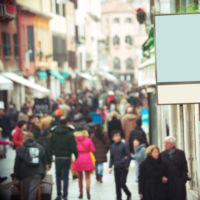Rethinking Your Reason to Be on the High Street
by Hugh Williams on 16th Jan 2019 in News


Here, Heather Dansie, insight director, Publicis Media, tells RetailTechNews that retailers need to re-evaluate why they are investing in a physical presence, if Britain's high streets are to survive. The UK was once a nation of shop keepers, but our high streets, malls, and retail parks are all in decline. The British retail consortium this year saw the greatest year-on-year drop in footfall for nearly a decade with no growth in footfall in any UK region. Grimsby has been named the ‘unhealthiest’ high street last month, by the RSPH which noted the Lincolnshire city has the highest percentage of empty shops in the country.
This isn’t just an economic problem, although a worryingly high number of jobs are at stake as big chains collapse. A high street represents the face of the people who live there and is the most visible way for a community to assess and define what makes them unique and special. A miserable-looking high street will always downgrade the value of that community, regardless of income and its prospects. So, as the focal point where people come together, hangout, and simply belong, the demise of the high street reflects the crisis in our sense of community. If we aren’t proud of where we live, we are less likely to contribute to it, creating a cycle of decline.
And whilst online shopping is believed to be the source of the decline – 73% of online shoppers believe online growth is responsible for physical stores closing according to Mintel – there are, of course, other reasons. Consumption fatigue, as well as prospects of a serious spending squeeze, are not conducive to purchases. Not only are we saturated with stuff, but we are fuelling a thriving secondary market place where the original brand or manufacturer doesn’t feature.
But worse than these functional challenges is perhaps that most high streets are boring. The New Economics Foundation classed 41% of town centres as ‘clones’, meaning that more than half the stores were chains. If there is no differentiation from your high street from year to year, or from venue to venue, it no longer becomes a place of leisure; it's just a functional place that can easily be replaced by a mobile app.
If Britain’s high streets are to thrive, brands need to completely rethink their purpose in community centres. They are no longer just places to buy things in a marketplace, but places to be. This cuts to the heart of the conflict because online retailers, with their ability to showcase a wide variety of stock, great prices, and a faster service, will undoubtedly win when it comes to the functional elements that drive loyalty.
So, driving footfall must tap into the emotional needs that communities are craving. Loneliness is a big problem and it is growing, with Age UK predicting that loneliness amongst the over-50s will increase by 49% in the next ten years. People are aware, too, that we are deskilling ourselves as we outsource and dedicate more of our time to technology, driving a desire for hands-on education. So there are real needs from the brands and media that exists in town centres (not just our trendy city centres) but perhaps for new purposes. Advertising contributes hugely to the look, feel, and sound of a high street community. When we consider the beauty of campaigns in the past, it should encourage us to see advertising as the art in our everyday lives.
Local and localised media are powerful ways of pumping pride back into local high streets. According to Mintel, 64% of people believe that ads focus far too much on London culture, so personalising content to make it more geographically relevant increases recall and consideration.
Collaboration with other businesses can bring greater elements of variety and surprise to in-store experiences. Building support networks and using advertising to communicate this is key. Visa’s Christmas advertising campaign this year was there to encourage shoppers to buy locally as they promote 100 local businesses across the country.
And, of course, retail environments are where brands build their experiences to develop lasting relationships with customers, as much of our online shopping is with brands that have a retail presence. Understanding the connection between the online and offline experiences allows brands to carve out different purposes for each space, for 49.3% of online sales come from store-based brands (ONS). Brands are exploring these new territories, whether it is Halifax running finance classes in their new coffeeshop-style bank in Oxford Street; Planet Organic inviting small brands to present sessions on health and wellbeing (from herbs to Christmas gifts); or H&M trialling the concept of a ‘Care and Repair’ centre in stores, brands encouraging shoppers to visit their high street by giving them reasons beyond shopping should increase their favourability.
At the moment, these retail experiences are few and far between as the high street – the fabric of our society – redefines its purpose in our lives. Media remains a key weapon in a brand’s armoury for driving footfall, as physical shops are still the mainstay of building relationships between brands and their customers.




Follow Fast Growth Brands